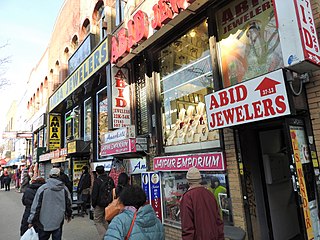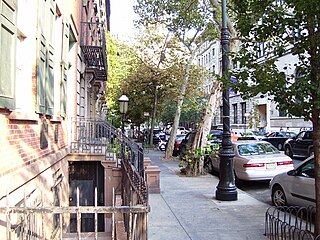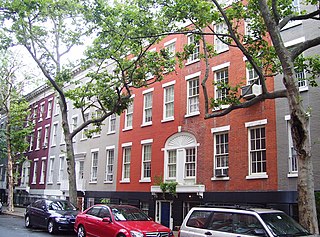
Jackson Heights is a neighborhood in the northwestern part of the borough of Queens in New York City. Jackson Heights is neighbored by North Corona to the east, Elmhurst to the south, Woodside to the west, northern Astoria (Ditmars-Steinway) to the northwest, and East Elmhurst to the north and northeast. Jackson Heights has an ethnically diverse community, with half the population having been foreign-born since the 2000s. The New York Times has called it "the most culturally diverse neighborhood in New York, if not on the planet." According to the 2010 United States Census, the neighborhood has a population of 108,152.

Cobble Hill is a neighborhood in the northwestern portion of the New York City borough of Brooklyn. A small neighborhood comprising 40 blocks, Cobble Hill sits adjacent to Brooklyn Heights to the north, Boerum Hill to the east, Carroll Gardens to the south, and the Columbia Street Waterfront District to the west. It is bounded by Atlantic Avenue (north), Court Street (east), Degraw Street (south) and the Brooklyn Queens Expressway (west). Other sources add to the neighborhood a rectangle bounded by Wyckoff Street on the north, Hoyt Street on the east, Degraw Street on the south, and Court Street on the west.

Clarence Samuel Stein was an American urban planner, architect, and writer, a major proponent of the garden city movement in the United States.

Turtle Bay is a neighborhood in New York City, on the east side of Midtown Manhattan. It extends from roughly 43rd Street to 53rd Street, and eastward from Lexington Avenue to the East River's western branch. The neighborhood is the site of the headquarters of the United Nations and the Chrysler Building. The Tudor City apartment complex is next to the southeast corner of Turtle Bay.

Gramercy Park is the name of both a small, fenced-in private park, and the surrounding neighborhood that is also referred to as Gramercy, in Manhattan in New York City.

The Dunbar Apartments, also known as the Paul Laurence Dunbar Garden Apartments or Dunbar Garden Apartments, is a complex of buildings located on West 149th and West 150th Streets between Frederick Douglass Boulevard/Macombs Place and Adam Clayton Powell Jr. Boulevard in the Harlem neighborhood of Manhattan, New York City. They were built by John D. Rockefeller Jr. from 1926 to 1928 to provide housing for African Americans, and was the first large cooperative aimed at that demographic. The buildings were designed by architect Andrew J. Thomas and were named in honor of the noted African American poet Paul Laurence Dunbar.

Charles B. J. Snyder was an American architect, architectural engineer, and mechanical engineer in the field of urban school building design and construction. He is widely recognized for his leadership, innovation, and transformation of school building construction process, design, and quality during his tenure as Superintendent of School Buildings for the New York City Board of Education between 1891 and 1923.

Pete's Tavern, located at 129 East 18th Street on the corner of Irving Place in the Gramercy Park neighborhood of Manhattan, New York City, is a pub food restaurant and the oldest continuously operating restaurant and bar in New York City.

George Frederick Pelham was an American architect and the son of George Brown Pelham, who was also an architect.

The Samuel J. Tilden House is a historic townhouse pair at 14-15 Gramercy Park South in Manhattan, New York City. Built in 1845, it was the home of Samuel J. Tilden (1814–1886), former governor of New York, a fierce opponent of the Tweed Ring and Tammany Hall, and the losing presidential candidate in the disputed 1876 election. Tilden lived in the brownstone from 1860 until his death in 1886. From 1881 to 1884, Calvert Vaux combined it with the row house next door, also built in 1845, to make the building that now stands, which has been described as "the height of Victorian Gothic in residential architecture" with Italian Renaissance style elements. Since 1906 it has been the headquarters of the National Arts Club, a private arts club.

Broadway–Flushing is a historic district and residential subsection of Flushing, Queens, New York City. The neighborhood comprises approximately 2,300 homes. It is located between 155th and 170th Streets to the west and east respectively, and is bounded on the north by Bayside and 29th Avenues, and on the south by Northern Boulevard and Crocheron Avenue. Broadway–Flushing is listed on the National Register of Historic Places.

St. Mark's Historic District is a historic district located in the East Village neighborhood of Manhattan, New York City. The district was designated a city landmark by the New York City Landmarks Preservation Commission in 1969, and it was extended in 1984 to include two more buildings on East 10th Street. It was listed on the National Register of Historic Places in 1974 and was expanded in 1985. The boundaries of the NRHP district and its expansion are now coterminous with those of the LPC.

First Houses is a public housing project in the East Village, Manhattan, New York City and was one of the first public housing projects in the United States. First Houses were designated a New York City Landmark and National Historic Landmark in 1974. They are managed by the New York City Housing Authority.

Village Preservation is a nonprofit organization that advocates for the architectural preservation and cultural preservation in several neighborhoods of Lower Manhattan in New York City. Founded in 1980, it has advocated for New York City designated landmark status for a variety of sites like the Stonewall Inn and Webster Hall. The organization and its Executive Director, Andrew Berman, have been described as influential in New York real estate, while some of its activities to prevent development and to support restrictive zoning have attracted criticism.

The MacDougal–Sullivan Gardens Historic District is a small historic district consisting of 22 houses located at 74–96 MacDougal Street and 170–188 Sullivan Street between Houston and Bleecker Streets in the South Village area of the Greenwich Village neighborhood of Manhattan, New York City.

The Sniffen Court Historic District is a small close-ended mews, running perpendicularly southwest from East 36th Street, between Third and Lexington Avenues in the Murray Hill neighborhood of Manhattan in New York City. The district, one of the smallest in New York City, encompasses the entire alley, which consists of 10 two-story brick stables built in 1863–1864 in the early Romanesque Revival style. The New York City Landmarks Preservation Commission designated Sniffen Court as a city historic district on June 21, 1966, and the district was added to the National Register of Historic Places on November 28, 1973.

Phipps Garden Apartments is an apartment complex in Sunnyside Gardens, Queens, New York City. It was built in 1931 by Phipps Houses, a philanthropic organization of the Phipps family to build model tenements for working-class families, along with Henry Wright of Sunnyside Gardens. It is located on 39th Avenue between 50th and 52nd Streets, adjacent to Sunnyside Gardens Park and Sunnyside Yard. Designed by Clarence Stein, The brick buildings feature intricate brick work and curved steel fire escapes. The buildings enclose a landscaped courtyard by landscape architect Marjorie Sewell Cautley.
The following is an alphabetical list of articles related to New York City. New York City is a city in the United States state of New York.





















